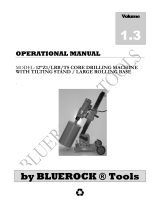
page 12
Maintaining Tools
Keep your tool in good repair by adopting a regular maintenance pro-
gram. Before use, examine the general condition of your tool. Inspect
guards, switches, tool cord set and extension cord for damage. Check
for loose screws, misalignment, binding of moving parts, improper
mounting, broken parts and any other condition that may affect its safe
operation. If abnormal noise or vibration occurs, turn the tool off im-
mediately and have the problem corrected before further use. Do not
use a damaged tool. Tag damaged tools “DO NOT USE” until repaired
(see “Repairs”).
Under normal conditions, relubrication is not necessary until the motor
brushes need to be replaced. After six months to one year, depending on
use, return your tool to the nearest MILWAUKEE service facility for the
following:
• Lubrication
• Brush inspection and replacement
• Mechanical inspection and cleaning (gears, spindles, bearings,
housing, etc.)
• Electrical inspection (switch, cord, armature, etc.)
• Testing to assure proper mechanical and electrical operation
MAINTENANCE
Cleaning
Clean dust and debris from vents. Keep the tool handles clean, dry and
free of oil or grease. Use only mild soap and a damp cloth to clean your
tool since certain cleaning agents and solvents are harmful to plastics and
other insulated parts. Some of these include: gasoline, turpentine, lacquer
thinner, paint thinner, chlorinated cleaning solvents, ammonia and house-
hold detergents containing ammonia. Never use fl ammable or combustible
solvents around tools.
WARNING!
To reduce the risk of injury, always unplug
your tool before performing any maintenance. Never
disassemble the tool or try to do any rewiring on
the tool's electrical system. Contact a MILWAUKEE
service facility for ALL repairs.
WARNING!
To reduce the risk of injury, electric shock and damage
to the tool, never immerse your tool in liquid or allow
a liquid to fl ow inside the tool.
Lubricating Rack and Pinion
Maintain a light coat of MILWAUKEE Type "E" Grease on the rack and pinion
gears to reduce friction and wear.
Lubricating the Spindle for Dymodrills with a Shear Pin
Before each use, clean and lubricate the spindle or spindle sleeve with
MILWAUKEE Type "E" Grease to prevent the spindle from seizing during
coring.
1. To maintain the spindle on shear pin models, remove the retaining ring
with a screwdriver. Then remove the spindle sleeve.
2. Remove dust and debris from the inside and outside diameter of the
spindle and spindle sleeve and from the water hole in the spindle. Place
a light coating of MILWAUKEE Type "E" grease on the spindle.
3. Replace the spindle sleeve onto the spindle. Make sure the spindle
sleeve rotates freely on the spindle. Then replace the retaining ring.
Replacing Vacuum Pad Gaskets
For Cat. No. 4115, 4125 & 4130 only.
Through normal use, the rubber gaskets on the underside of the vacuum
pads can become worn, requiring replacement. If replacement is required,
take the pad to an authorized service center or replace the gasket as fol-
lows:
1. Remove the old gasket and thoroughly remove the old glue from the
groove.
2. Squeeze a continuous bead of rubber cement (Cat. No. 44-22-0060)
in the entire bottom of the groove.
3. Immediately place a new gasket (Cat. No. 43-44-0570) in the groove
and press fi rmly in place.
4. Turn the pad over and place the gasket side on a smooth fl at surface
and apply pressure to all edges of the pad.
5. Allow cement to dry for 24 hours before using.
For Cat. No. 4120 only.
With normal use, the rubber gasket on the underside of the base can become
worn, requiring replacement. If replacement is required, take the base to an
authorized service center or replace the gasket as follows:
1. Remove the motor and bit.
2. Tip the Dymorig on its back so that the wheels point down.
3. Remove the old gasket.
4. Squeeze a continuous bead of rubber cement (Cat. No. 44-22-0060)
in the entire bottom of the groove.
5. Place the new gasket (Cat. No. 43-44-0605) into the groove making
sure it is pushed in completely.
6. Stand the Dymorig upright again.
7. Reinstall the motor and bit.
Cleaning the Filter on the Vacuum Pump
Periodically clean the fi lter felts to keep the vacuum pump operating ef-
fi ciently. To clean the fi lter felts, remove the plastic jar and remove the felts
from the plastic tube. Remove dust and debris from the felts and clean the
plastic jar. Then replace the felts on the plastic tube and position the jar
onto the fi lter assembly.
Repairs
If your tool is damaged, return the entire tool to the nearest service cen-
ter.















